There are many great microphones on the market today. Many of them are condenser microphones, however, the distinction between good and great will generally come from versatility and accessibility. As condenser microphone technology has improved, many variations of the condenser have become available.
However the microphones with truly great quality tend to be out of reach to the budget musician or engineer. A traditional and vintage sound is produced through expensive hardware parts. In this article, we will review the factors of a great condenser microphone and overview the best choices on the market.
Why Trust Us?
I am currently a student studying audio technology and computer science. As a student of computers and audio, I have created several applications of audio and computer (the current mainstream form of audio recording and production) that include but are not limited to, movement audio, digital audio signal processing, mobile applications, and audio engines.
I have spent an extensive amount of time in American University’s state-of-the-art studio where I have recorded, mixed, and mastered several musician’s tracks and albums. I have written the blueprints (some have come to fruition) to a variety of loudspeakers which provide, in some sense, the opposite function of a microphone.
But I digress. The following section will include the various features of a microphone that make it a great value.

Credit: Georg Neumann GmbH
Top Pick: Neumann U87 Ai
Ultimate versatility, use this microphone for radio, podcasts, music, television, and controlled movie settings.
What Is A Condenser Microphone?
Before understanding what a condenser microphone is, it is important to understand what a general microphone does. A microphone is essentially a transducer of sound pressure waves to electrical current.
The microphone is then attached to some type of wire (usually an XLR) and sends the electrical current to a sound card, audio interface, or another form of audio processor.
There are several types of microphones. The type will be determined by the type of transducer within the microphone. As opposed to a dynamic microphone, which utilizes a diaphragm/magnet or a ribbon microphone that uses an aluminum coil, the condenser microphone uses a charged plate in order to transduce an audio signal.
This is accomplished by sending an electrical charge known as phantom power to the capacitor within the microphone. This is an essential point of understanding when choosing a condenser microphone, without access to phantom power, you will not be able to use a condenser.
What Does Phantom Power Do?
Phantom power is the principle that distinguishes a condenser microphone from other types. There are advantages and disadvantages to phantom power, but I firmly believe the advantages outmatch the disadvantages, especially for any beginner to intermediate recording engineer.
Disadvantages
There are two potential downsides to phantom power. Because of the integration of an electrical signal, the electronic circuitry produces a minimal amount of noise during the process of recording. Because the microphone is powered by electricity, you can only record to a certain level.
So if you are trying to produce loud, huge, or “in-your-face” audio, be prepared to create the sound in post production. Generally, good microphone designs will hide these setbacks, diminishing background noise and allowing for large amounts of dynamic range.
Advantages
Because a condenser microphone is more complex (and usually more expensive), they are generally used in settings where quality demand is high and the setting is also controlled. Due to the smaller mass (in comparison to dynamics), the signal generated from a condenser microphone will be more accurate.
This is based on the idea that the sound signal is able to move the condenser in a way that accurately and precisely matched the source (generator of the signal). However, this is usually seen in higher quality condenser microphones. The lowest quality condenser will produce a sound that rivals the worst dynamic microphones.
Types of Condenser Microphones
As if it isn’t complicated enough, there is an essential distinction that must be made between two types of condenser microphones, the small-diaphragm and large-diaphragm condenser microphone.
The Differences
A large-diaphragm condenser microphone is given that name when the capacitors that transduce signal are larger than one inch in diameter. Although it sounds trivial, this specification creates an entirely different sound. The enlarged diameter allows for a larger surface to be moved and thus, a higher level of sensitivity in comparison to a small-diaphragm.
A higher charged plate also lends itself to more power, therefore, the output signal of a large-diaphragm condenser will be significantly higher than its counterpart (all things equal, a large-diaphragm condenser’s sensitivity is 20-23 mV/Pa where a small-diaphragm will range from 9-11 mV/Pa).
Frequency response is also significantly changed based on diameter (we will explain what this term means in a moment). The large-diaphragm condenser will generally reproduce deep bass frequencies at a higher quality than a small-diaphragm condenser.
Alternatively, the small-diaphragm is much better at transducing higher frequencies. While recording live instruments, the transient notes are generally reproduced better with a small-diaphragm condenser than a large diaphragm, however, the proximity effect (amplification of bass notes) is usually more apparent in a small-diaphragm.
This doesn’t equate to a lack of bass due to proximity in regards to a large-diaphragm condenser, however, the microphone tends to reproduce this audio at a better quality.
When Do I Use a Large-Diaphragm or Small-Diaphragm?
As stated above, a slight change in diameter has an astounding effect on the type of sound produced. Based on this, you should lean towards a small-diaphragm in some situations and a large in others. As a general rule-of-thumb, you should utilize a large-diaphragm condenser microphone in these situations:
- Recording a singer
- Recording room noise
- Recording piano
- Recording bass heavy theatrical instruments
Alternatively, you should use a small-diaphragm condenser in these situations:
- Recording tom drums
- Overhead microphones
- Recording guitar
- Recording bass guitar
Microphone Specifications
Understand the type of microphone that will provide you the best value is important. It can be argued that understanding the specifications is more important. The following section will explain what makes a great microphone.
Polar Patterns
There are many types of microphones, within that specification, there are many types of ways to record using those microphones. A polar pattern will explain how a microphone will record sound. There are three main types of polar pattern, cardioid, omnidirectional, and bidirectional.
Cardioid – will record the audio coming from the face of the microphone transducer.
Omnidirectional – will record audio surrounding the transducer, in essence, this polar pattern records every direction.
Bidirectional – will record audio coming from the front and behind the transducer. Many high-end microphones will come with a set polar pattern. On the other hand, there are many great low to mid-range microphones that will have an assortment of polar patterns, some will have all three types! These microphones are referred to as “multi-patterned microphones”.
Frequency Response
Frequency response is a quintessential feature to look for when deciding what microphone to choose. The frequency response explains the range in which a microphone will pick up audio. The human ear can hear frequencies between 20Hz-20,000Hz however, many microphones will pick up between 50Hz-15,000Hz, etc.
The importance of this specification cannot be overstated. If you plan to record vocals and incorporate a microphone with a 20Hz-10,000Hz frequency response, you are losing a large portion of the source audio and thus, the integrity of your project is compromised.
Response Curves
Intertwined with the concept of frequency response, the response curve explains how a microphone reacts to certain frequencies. Building on our previous example, you are using a microphone with a 20Hz-10,000Hz, however, the response curve suggests that the microphone enhances the 3,000Hz-6,000Hz range (the primary frequencies of many vocalists).
Using this microphone may create an interesting and “airy” quality to anyone you are recording, therefore, this may not be a bad choice as a secondary vocalist microphone. The response curve is what provides character to a microphone.
Proximity Effect
Also mentioned previously, the proximity is not as much a specification as it is a characteristic. The proximity effect characterizes how the microphone interacts with source audio as it approaches the source. For example, condenser microphones are notorious for creating higher levels of bass frequencies as they approach an audio source.
SPL-Handling
Essential to understanding when purchasing a condenser microphone, the handling of SPL (sound pressure level)is crucial to understand. This explains how the microphone will work in high audio situations. As an example, if you work with metal musicians, you need a microphone that can handle high levels of SPL.
If you try to record louder audio with a microphone that cannot handle the SPL, you will produce overly distorted audio that in effect, will ruin the quality of your record or production.
The main aspect you should note when searching for a microphone is the quality of materials and hardware used in the microphone. If you have the ability to purchase a $50 microphone with the highest quality hardware, it will be hard to discern the difference with a microphone that costs 100x the price.
The Competition
After hours of testing and research, here's the final competition.
| Instrument | Rating | Current Pricing |
|---|---|---|
Neumann U87 Ai | Considered an industry standard for recording vocalists |  |
Audio Technica AT2020 | Provides a good frequency response curve |  |
MXL V67G | Great reproduction of vocal qualities or instruments that feature similar characteristics. |  |
Rode NT-1A | Has been known to produce warm bass qualities |  |
Nuemann TLM-102 | Can be used in a broad range of different applications |  |
Blue Spark | Distinguishes itself from other microphones due to the depth it can create in recordings |  |
The Best Microphone On The Market:
Neumann U87 Ai

Credit: Georg Neumann GmbH
As stated above, the Neumann U87 Ai microphone is the best condenser microphone on the market today. In my experience, I have used the U87 for just about every application, on drums, vocals, bass, saxophone, piano, the list goes on.
The U87 is not only versatile but it is considered an industry standard for recording vocalists. This is due to the warm bass response as you move closer to an audio source. This generates a characteristic effect on the vocal that can be heard on the majority of modern pop hits.
As far as specifications are concerned, the U87 provides for almost every situation. The U87 incorporates cardioid, bidirectional (written as figure-8 on the Nuemann website), and omnidirectional polar patterns into its repertoire of features. This provides for the ultimate versatility, allowing you to use this microphone for radio, podcasts, music, television, and controlled movie settings.
The U87 has been in production since 1967 however, the U87 Ai has been in production since 1986. The primary difference is based on the circuitry. The modern U87 allows for a higher range in headroom, this refers to the SPL handling capabilities as well as an increased dynamic range. The signal noise (noise generated from the phantom power) has been reduced by a ratio of 3dB.
The modern day U87 has a 10dB pad that takes into account any situation where you may need to have a higher level of SPL handling. This is especially important when utilizing the U87 for close-micing purposes. I have used this feature to great effect when recording through a bass drum tunnel.
Without the 10dB pad, the signal would distort, however with the pad, I can maintain the great clarity and warm bass response of the U87 without the worry of clipping or distortion. There is a low-frequency cutoff switch that acts as a handler (usually for any unwanted proximity effect frequencies) for frequencies below a certain level.
Lastly, the U87 has an astoundingly smooth frequency response curve.

Credit: Fox Audio Research
Neumann boasts that this response curve will remain smooth in cardioid settings at a range of 30cm-40cm, in the bidirectional mode at 15cm-20cm.
Previous to the U87 Ai, these capabilities were unmatched as many microphones created noticeable amounts of noise, proximity effect bass, and would fail to meet the specified frequency response curve stated in any marketing material.
Overall, the U87 is a magnificent large-diaphragm microphone that, in some ways, defies the general characteristics of a large-diaphragm microphone. The impressively smooth frequency response, filter attenuation, SPL handling capability, and assortment of polar patterns provides for a versatile and accessible experience.
Upon first use of this microphone, I guarantee you will understand why the microphone is so capable.
The impressively smooth frequency response, filter attenuation, SPL handling capability, and assortment of polar patterns provides for a versatile and accessible experience. Upon first use of this microphone, I guarantee you will understand why the microphone is so capable.
The downside to this microphone is the cost. If you can find this microphone for less than $2,000, buy it! The current price on Amazon is . However, you truly get a huge bang for your buck.
Other Options To Consider:
Audio Technica AT2020

Credit: Audio-Technica U.S., Inc
Arguably the greatest “bargain” microphone, the AT2020 is a staple microphone in most intermediate to professional recording studios. The AT2020 is a small-diaphragm condenser microphone that provides a good frequency response curve.
Unfortunately, you can only use this microphone as a cardioid microphone. On the other hand, you can use it for many folk-rock to rock to jazz to R&B applications. The AT2020 will cost around $79-$130.
Pros
- Affordable
- Accessible
- Versatile
Cons
- SPL handling is poor
MXL V67G

Credit: MXL
The MXL V67G is a great microphone to use on a vocalist. Not only is the look of the microphone appealing (it is gold plated with a blue body), the capacity on the microphone is 32mm. This provides for a great reproduction of vocal qualities or instruments that feature similar characteristics.
Alternatively, the bass qualities of most vocalists are more pronounced, therefore, if you are not looking for a melancholic or full-bodied sound, this may not be for you. The MXL V67G will cost around $50-$100.
Pros
- Affordable
- Great for Vocals
- Usually comes with a case and pop filter
Cons
- Lack of versatility
Rode NT-1A

Credit: RØDE Microphones
The Rode NT-1A has been considered one of the best condenser microphones for hip-hop and rap ever since the 1980s. It is a large-diaphragm condenser microphone that maintains a cardioid polar pattern. The NT-1A has been known to produce warm bass qualities, while also highlighting higher level frequencies which makes this microphone as a quintessential vocalist microphone.
The NT-1A is also useful in other applications such as overhead micing, room micing, and guitar recordings. The NT-1A can be found ranging from $250-$400
Pros
- Versatile
- Classic
- Comparable to some Neumann models
Cons
- SPL handling is poor
Nuemann TLM-102

Credit: Georg Neumann GmbH
Often considered the “little brother” of the Nuemann U87, you receive close to the same characteristics as the U87 Ai for a third of the price. The SPL handling of this microphone is only rivaled to other Nuemann models at a max of 144dB.
The response curve shows a boost around 6,000Hz and the model is offered in two different styles. Like the U87, this microphone can be used in a broad range of different applications. However, the price is still steep at around $900-$1500.
Pros
- Similar to the U87 with a few drawbacks
- Versatile
- Professional quality
Cons
- Expensive
Blue Microphones: Blue Spark

Credit: Blue
Blue microphones try to recreate the vintage feel with their microphones. When the Blue Spark was released, many people praised the manufacturer for reproducing the look of a vintage microphone with the quality of a modern microphone. The Blue Spark distinguishes itself from other microphones due to the depth it can create in recordings.
Based on the placement, you can create several layers to your soundscape before post-production, a feature often overlooked in many modern recordings. It also has a “Focus-Control Switch” that enables you to enhance bass frequencies in a recording. The Blue Spark is priced between $200-$300.
Pros
- Vintage feel
- Great value
- Great bass response
- Comes with a shockmount and pop filter
Cons
- Not very versatile

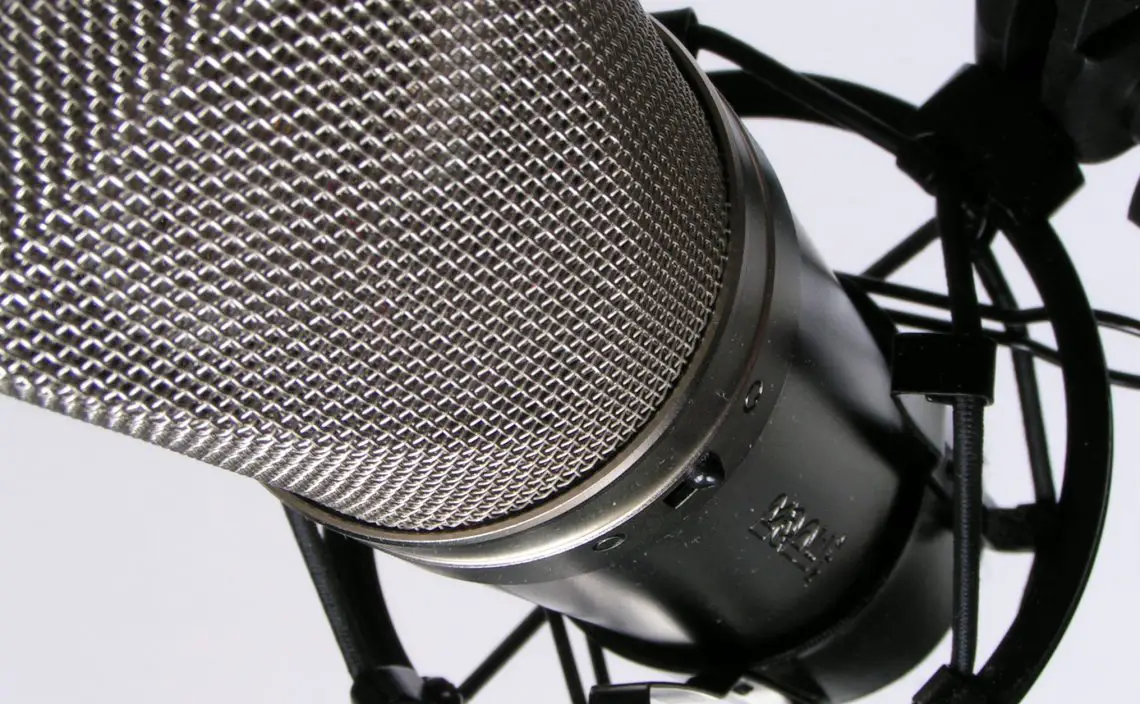

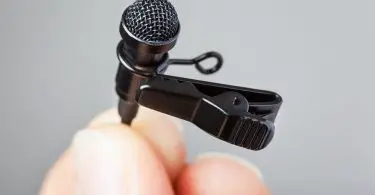
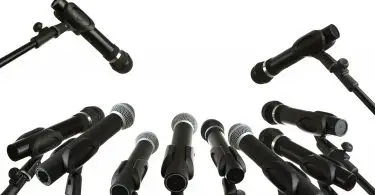
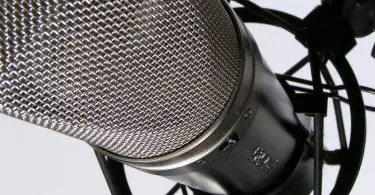
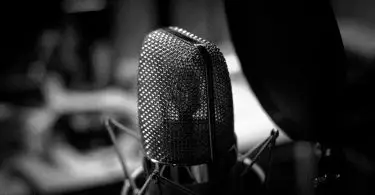
This article is one of our best (at least I think so!) Not sure if anyone has personal experience with condenser mics they would like to share?